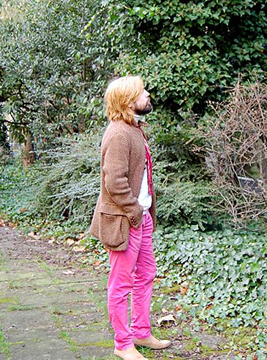
On Monday night, the winner of this year’s Turner Prize was announced—the fifteenth since its inception in 1984. The prize itself has become synonymous with a sort of willful controversy, symbolic of the close relationship between contemporary art and the mass media in the UK. It’s the prize that launched a thousand punchlines: right now, somewhere in the world, someone is pointing at a pile of discarded orange peel and fish heads and saying, “You could win the Turner Prize with that.” This kind of sanitized, camp shock—exemplifed in Damien Hirst’s bisected cattle, Tracey Emin’s messy bed, or the Chapman brothers’ mutilated mannequins—fuelled huge public interest in contemporary art, dumping it into mainstream consciousness after decades of fringe activity (note the distinction between these artists and previous winners). A combination of titillation and curiosity packed out the Turner shows of the late nineties and made household names of Hirst, Emin, and the Chapmans. It could be argued that that surge of interest powered the foundation and continued popularity of Tate Modern, which opened in 2000. In any case, as artistic practice changes, that intimacy between art and the printed word looks to be compromised. The press this year isn’t happy; this year’s shortlist isn’t shocking enough.
In a post-announcement interview, Mark Leckey, the winning artist, voiced his dismay at the level of vitriol directed towards the shortlisted artists from the press. Many publications saw the line-up (alongside Leckey: Goshka Macuga, Cathy Wilkes, and Runa Islam) as sign of some sort of artistic demise, citing the overtly intellectual and aesthetically dry approach exemplified by Macuga’s archaeological snufflings through the Tate archive as evidence that art had finally disappeared up its own theoretical fundament and completely lost touch with its audience. “What I was warned to expect, but still shocked me, was how much obloquy and hatred the prize generates,” said Leckey.
Many journalists seem to long nostalgically for the days of the Young British Artists, who were guaranteed to at least get people talking about the art and were easy to summarize in a written overview of the exhibition (however, if you’re of a certain frame of mind, the very notion of a room with the lights turning on and off being considered art, let alone winning a prize, is enough to boil the blood). It’s been interesting to note how desperately some writers have clung to this notion even this year. Leckey’s work, an esoteric filmed lecture delivered by the artist and which touches on Philip Guston, James Cameron’s Titanic, and Homer Simpson in a kind of amalgam of fiction and reality (it’s better than it sounds), led to the headline “D’oh! Homer Simpson wins the Turner Prize in a decidedly uncontroversial year.” Runa Islam’s film of a woman wandering slowly round an art gallery, toying with and sweeping china objects off their plinths as she does, filmed in slow, dreamy motion, was described by a senior arts correspondant as “a mighty smashfest” (and there’s more). But is anyone really going to get upset about that?
This kind of criticism has gathered steam since 2004, when Jeremy Deller’s work–again, a kind of archiving of popular and unpopular culture in the UK–failed to raise sufficient heckles and grumblings began about the prize’s demise. Tomma Abts’s win in 2006 for a sequence of muted geometric abstractions looked like the final straw for the media conflation of Turner Prize art with the theatrical shock tactics of the Chapmans and Damien Hirst. It’s tempting to suggest, as JJ Charlesworth does in this month’s Art Review, that the more or less blanket condemnation of this year’s line-up looks like an admission of failure on the part of the media—a refusal to engage intellectually with the work displayed and maybe part of this “crisis of art criticism” we keep hearing about. Dismissing something as “too intellectual” is something of a shot in the foot from art critics paid to analyze and interpret works of conceptual art. And shocking art allows you the luxury of an easy write-up, because the condition of being shocked by a work of art necessarily eclipses a cerebral response.
Leckey himself has addressed the press’s relationship with contemporary art in lucid terms, claiming that the ascendance of the YBA’s has had a negative impact on art in general. The danger, of course, is in taking this all too seriously, as though the Turner were actually representative of artmaking today; obviously contemporary art is too diverse, sprawling, and elusive to be easily confined into dog show-like competition. And yes, it’s only a blip on the art world radar, internationally speaking. However, there’s no reason why it couldn’t claim some validity among the falling masonry of the economic collapse, asserting its place in a national culture that might learn to value intellectual inquiry over glib one-liners.
And now, a question: to what extent is press coverage involved in the idea of controversy in art?




Pingback: Letter from London: Turner Round, Bright Eyes! | Art21 Blog
Pingback: Bruce High Quality Foundation University | Art21 Blog
Pingback: Letter from London: Scrooged | Art21 Blog